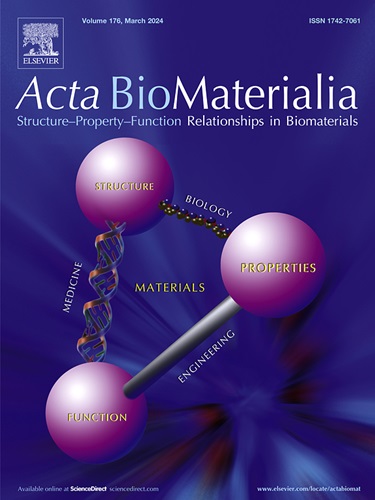由铁蛋白修饰的糖原衍生的DNA纳米疫苗用于靶向递送到未成熟树突状细胞并促进Th1细胞分化。
IF 9.4
1区 医学
Q1 ENGINEERING, BIOMEDICAL
引用次数: 0
摘要
DNA疫苗已成为晚期癌症治疗的有力手段。尽管开发了各种递送系统来增强DNA疫苗的免疫原性,但许多递送系统仍然面临着诸如DNA浓缩有限,体内降解迅速以及对淋巴结(LNs)靶向不足等挑战。具有可修饰表面的树状大分子在DNA缩聚过程中表现出高效率,但其合成过程极其复杂。本研究利用阳离子糖原(一种天然的枝状枝状聚合物)作为核心结构,进行高效的DNA凝聚和传递,保证了良好的生物相容性。通过将铁蛋白轻链连接到糖原表面,由于其对未成熟树突状细胞(dc)上的SCARA5受体的亲和力,可以实现对LNs的活性靶向,促进疫苗迁移到LNs。此外,一个单独的编码佐剂IL-12的质粒被共同递送,以进一步提高DNA纳米疫苗的免疫原性。体内和体外实验证实了该DNA疫苗的有效转染能力,显示出促进DC成熟,增加抗原呈递和Th1细胞分化,从而提高体内抗肿瘤效率。这种创新的多基因共载DNA疫苗为联合基因治疗提供了宝贵的见解,拓宽了对非病毒基因载体的研究视野。意义声明:DNA疫苗面临着DNA凝聚有限、降解迅速和对淋巴结(LNs)靶向不足等挑战,导致免疫原性普遍较弱。本研究通过将铁蛋白轻链连接到天然树突状糖原上,开发了一种新型纳米疫苗,用于同时递送双质粒。阳离子化的糖原提供了强大的DNA凝聚能力,同时保证了纳米疫苗优异的稳定性。铁蛋白轻链的存在导致树突状细胞(dc)的有效靶向,促进其迁移到LNs。此外,编码佐剂IL-12的质粒与抗原质粒共结合以减轻免疫抑制环境。这一策略显著提高了DNA疫苗的免疫原性,在癌症免疫治疗中显示出高效率。本文章由计算机程序翻译,如有差异,请以英文原文为准。

DNA nanovaccines derived from ferritin-modified glycogens for targeted delivery to immature dendritic cells and for promotion of Th1 cell differentiation
DNA vaccines have emerged as a powerful approach for advanced cancer therapy. Despite the development of various delivery systems to enhance the immunogenicity of DNA vaccines, many still face challenges such as limited DNA condensation, rapid degradation in vivo and insufficient targeting to lymph nodes (LNs). Synthetic dendrimers with modifiable surfaces exhibit high efficiency in DNA condensation, but their synthesis is extremely complex. This study utilizes cationic glycogen, a natural branched dendrimer-like polymer, as the core structure for efficient DNA condensation and delivery, ensuring good biocompatibility. By connecting ferritin light chain to the glycogen surfaces, active targeting of LNs can be achieved due to its affinity for the SCARA5 receptor on immature dendritic cells (DCs), facilitating vaccine migration to the LNs. In addition, a seperate plasmid encoding adjuvant IL-12 was co-delivered to further boost the immunogenicity of the DNA nanovaccine. In vivo and in vitro experiments confirmed the effective transfection capability of this DNA vaccine, demonstrating promoted DC maturation, increased antigen presentation, and Th1 cell differentiation, resulting in improved anti-tumor efficiency in vivo. This innovative multi-gene co-loaded DNA vaccine offers valuable insights into combined gene therapy and broadens the research horizon on non-viral gene carriers.
Statement of Significance
The DNA vaccine encounters challenges such as limited DNA condensation, rapid degradation and insufficient targeting to lymph nodes (LNs), resulting in generally weak immunogenicity. In the current study, a novel nanovaccine is developed by connecting ferritin light chain to natural dendrimer glycogen, for simultaneous delivery of dual plasmids. The cationized glycogen provides strong DNA condensation ability, while ensuring excellent stability of the nanovaccine. The presence of ferritin light chain leads to effective targeting of dendritic cells (DCs), facilitating its migration to LNs. Moreover, the plasmid encoding the adjuvant IL-12 is co-incorporated with the antigen plasmid to mitigate the immunosuppression environment. This strategy significantly improves the immunogenicity of DNA vaccines, demonstrating high efficiency in cancer immunotherapy.
求助全文
通过发布文献求助,成功后即可免费获取论文全文。
去求助
来源期刊

Acta Biomaterialia
工程技术-材料科学:生物材料
CiteScore
16.80
自引率
3.10%
发文量
776
审稿时长
30 days
期刊介绍:
Acta Biomaterialia is a monthly peer-reviewed scientific journal published by Elsevier. The journal was established in January 2005. The editor-in-chief is W.R. Wagner (University of Pittsburgh). The journal covers research in biomaterials science, including the interrelationship of biomaterial structure and function from macroscale to nanoscale. Topical coverage includes biomedical and biocompatible materials.
 求助内容:
求助内容: 应助结果提醒方式:
应助结果提醒方式:


